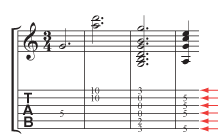Complex Type: staff-details
Description
The staff-details element is used to indicate different types of staves. The print-object attribute is used to indicate when a staff is not printed in a part, usually in large scores where empty parts are omitted. It is yes by default. If print-spacing is yes while print-object is no, the score is printed in cutaway format where vertical space is left for the empty part.
Derived By
Restricting xs:anyType
Attributes
| Name | Type | Required? | Default | Description |
|---|---|---|---|---|
| number | staff-number | No | The optional number attribute specifies the staff number from top to bottom on the system, as with clef. |
|
| show-frets | show-frets | No | Indicates whether to show fret numbers or fret letters. If not specified, numbers is used. |
|
| print-object | yes-no | No |
|
|
| print-spacing | yes-no | No |
|
Content Model
Contains elements as defined in the following table.
| Component | Type | Occurs | Default | Description |
|---|---|---|---|---|
 |
1..1 |
|
||
| staff-type | staff-type | 0..1 | The staff-type value can be ossia, cue, editorial, regular, or alternate. An alternate staff indicates one that shares the same musical data as the prior staff, but displayed differently (e.g., treble and bass clef, standard notation and tab). |
|
| staff-lines | xs:nonNegativeInteger | 0..1 | The staff-lines element specifies the number of lines for a non 5-line staff. |
|
| staff-tuning | staff-tuning | 0..* |

The staff-tuning type specifies the open, non-capo tuning of the lines on a tablature staff. |
|
| capo | xs:nonNegativeInteger | 0..1 |

The capo element indicates at which fret a capo should be placed on a fretted instrument. This changes the open tuning of the strings specified by staff-tuning by the specified number of half-steps. |
|
| staff-size | non-negative-decimal | 0..1 | The staff-size element indicates how large a staff space is on this staff, expressed as a percentage of the work's default scaling. Values less than 100 make the staff space smaller while values over 100 make the staff space larger. A staff-type of cue, ossia, or editorial implies a staff-size of less than 100, but the exact value is implementation-dependent unless specified here. Staff size affects staff height only, not the relationship of the staff to the left and right margins. |
|
Referenced By
- Element staff-details
Definition
<xs:complexType name="staff-details">
<xs:annotation>
<xs:documentation>The staff-details element is used to indicate different types of staves. The optional number attribute specifies the staff number from top to bottom on the system, as with clef. The print-object attribute is used to indicate when a staff is not printed in a part, usually in large scores where empty parts are omitted. It is yes by default. If print-spacing is yes while print-object is no, the score is printed in cutaway format where vertical space is left for the empty part.</xs:documentation>
</xs:annotation>
<xs:sequence>
<xs:element name="staff-type" type="staff-type" minOccurs="0">
<xsd:annotation>
<xsd:documentation>The staff-type value can be ossia, cue, editorial, regular, or alternate. An alternate staff indicates one that shares the same musical data as the prior staff, but displayed differently (e.g., treble and bass clef, standard notation and tab).</xsd:documentation>
</xsd:annotation>
</xs:element>
<xs:element name="staff-lines" type="xs:nonNegativeInteger" minOccurs="0">
<xs:annotation>
<xs:documentation>The staff-lines element specifies the number of lines for a non 5-line staff.</xs:documentation>
</xs:annotation>
</xs:element>
<xs:element name="staff-tuning" type="staff-tuning" minOccurs="0" maxOccurs="unbounded">
<xsd:annotation>
<xsd:documentation>The staff-tuning type specifies the open, non-capo tuning of the lines on a tablature staff.</xsd:documentation>
</xsd:annotation>
</xs:element>
<xs:element name="capo" type="xs:nonNegativeInteger" minOccurs="0">
<xs:annotation>
<xs:documentation>The capo element indicates at which fret a capo should be placed on a fretted instrument. This changes the open tuning of the strings specified by staff-tuning by the specified number of half-steps.</xs:documentation>
</xs:annotation>
</xs:element>
<xs:element name="staff-size" type="non-negative-decimal" minOccurs="0">
<xs:annotation>
<xs:documentation>The staff-size element indicates how large a staff space is on this staff, expressed as a percentage of the work's default scaling. Values less than 100 make the staff space smaller while values over 100 make the staff space larger. A staff-type of cue, ossia, or editorial implies a staff-size of less than 100, but the exact value is implementation-dependent unless specified here. Staff size affects staff height only, not the relationship of the staff to the left and right margins.</xs:documentation>
</xs:annotation>
</xs:element>
</xs:sequence>
<xs:attribute name="number" type="staff-number">
<xsd:annotation>
<xsd:documentation>
</xsd:documentation>
</xsd:annotation>
</xs:attribute>
<xs:attribute name="show-frets" type="show-frets">
<xsd:annotation>
<xsd:documentation>
</xsd:documentation>
</xsd:annotation>
</xs:attribute>
<xs:attributeGroup ref="print-object" />
<xs:attributeGroup ref="print-spacing" />
</xs:complexType>
